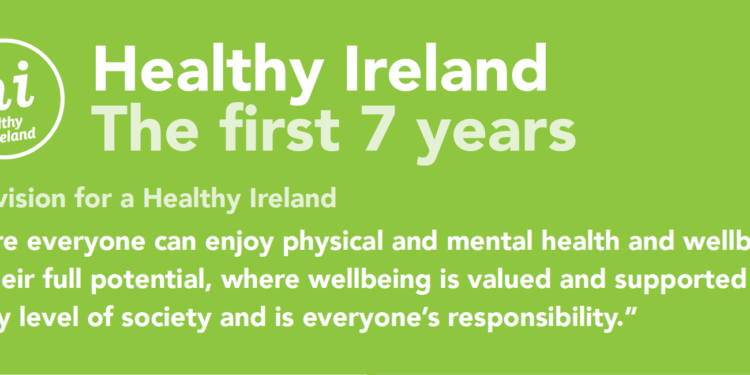Minister for Health, Stephen Donnelly TD and Minister of State for Public Health, Well Being and National Drugs Strategy Frank Feighan TD, have today published the Healthy Ireland Strategic Action Plan 2021-2025. A core component of the implementation of Sláintecare, this Healthy Ireland Strategy will have a particular emphasis on reducing inequalities. It will involve a comprehensive cross-government approach, with a total of 14 Government Departments responsible for implementing actions for the next 5 years.
Taoiseach Micheál Martin said: “I’m delighted to be publishing the Healthy Ireland strategic action plan today.Improving and supporting the health and wellbeing of the people of Ireland is central to the work of government. We are thankfully beginning to slowly emerge from the pandemic and we know more than ever before that people have a greater focus on their health, and an understanding of their overall sense of wellbeing and how it can be impacted so greatly.
“Healthy Ireland gives us a vision of how we as a society can work together to bring about a Healthier Ireland where everyone, can enjoy physical and mental, health and wellbeing, to their full potential. We will be placing a special emphasis on health inequalities in this plan and making sure that all people are ultimately enabled and empowered to live healthier lives. We will make sure to reach everyone, and that no one is left behind.”
The Healthy Ireland Strategic Action Plan builds on the success of the Healthy Ireland Framework, which was published in 2013. The Strategic Action Plan contains 56 actions across six themes which will be implemented over the next five years. Each action has a lead government department from across fourteen separate Government Departments. In the first seven years of implementation, Healthy Ireland through its partnerships has built cross-society foundations which will help it deliver into the future.
Minister Donnelly said: “Healthy Ireland is a core part of the implementation of Sláintecare in particular on keeping people well in their own homes and communities, and helping people to stay out of hospital for as long as possible. Since the publication of the Healthy Ireland Framework 7 years ago, significant progress has been made to implement our vision where everyone can enjoy physical and mental health and wellbeing to their full potential.
“National policies and strategies have been developed and are being implemented across a range of health behaviours that impact the health and wellbeing of our people, including physical activity, obesity, smoking, alcohol, sexual health and skin cancer. All this work has set very strong foundations on which to build for the next five years.
“We know that health and wellbeing is not evenly distributed across the population with our most deprived communities bearing a higher burden of chronic disease with increased levels of mortality. I am especially pleased that this plan aims to directly begin to address those communities most impacted by the social determinants of health through the inclusion of a new Sláintecare Healthy Communities programme, working in particular with Local Authorities, other government departments, NGOs, and the HSE to tackle health inequalities.”
Partnership is the cornerstone of Healthy Ireland. COVID-19 has highlighted the importance of bringing together key players and stakeholders, to work together to a common goal, both at a local and a national level. This next phase of Healthy Ireland will build on these partnerships.
Minister Frank Feighan said: “As we navigate our way through this time we are reminded again and again of the importance of good health, access to services, healthy environments, and the promotion of resilience, and that is why the timing of the publishing of this Healthy Ireland Strategic Action Plan is so important.
“Partnership has been the cornerstone of Healthy Ireland and the work so far has brought together key players and stakeholders, to work together towards a common goal, both at a local and a national level. This next phase of Healthy Ireland is no different. Healthy Ireland is bringing together people and organisations from the length and breadth of the country to address the risks to our health. We’ll be linking with Government Departments, Public Bodies and Organisations, Businesses and Employers, Sports and Voluntary Groups, Communities and Families. For this new plan there are many new partners coming to the table with exciting and ambitious projects.”
Among some of the targets for the next 3 years Healthy Ireland will aim to deliver are:
- Implementation of a healthy campus programme in 30 third level institutions.
- Help 4500 people to live in their own home with dignity and independence through the Sláintecare age-friendly healthy homes scheme.
- Develop new policies and action plans addressing sexual health, physical activity, nutrition, obesity and mental health promotion.
- Add 500 more clubs to the GAA health clubs model, as well as drive participation amongst other sporting organisations.
- By 2022 develop 18 Sláintecare healthy communities in disadvantaged areas
The ongoing implementation of Healthy Ireland is a key action under Sláintecare. Prevention of illness, in addition to supporting people to live healthier lives, is also a vital element in reducing the demand for hospital services and improving quality of life.
Laura Magahy, Deputy Secretary at the Department of Health with responsibility for the implementation of Sláintecare, including Healthy Ireland, said:
“One of the key principles of Sláintecare is to promote health and wellbeing and prevent illness and this principle embodies all that Healthy Ireland seeks to achieve. The Healthy Ireland Framework provides the architecture to address the social determinants of health and thereby the prevention of chronic disease and other avoidable illness and incapacity. We have ambitious plans over the next 5 years and I look forward in particular to the Sláintecare Healthy Communities Programme, which will provide additional health resources to people living in the areas of highest deprivation in the country.”











